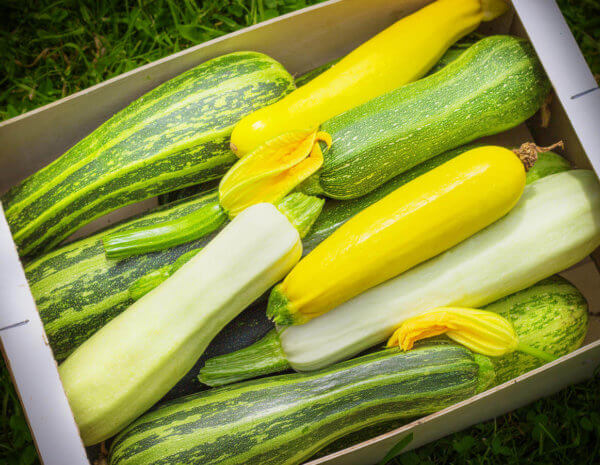Anachronistic Squash
by Kara Cromwell
Broadcast 9.2018, 7.2020, and 9.14 & 9.17.2022

iStock photo
Listen:
August had just begun when a friend delivered my first hand-me-down squash of the summer: a round, green variegated giant that had reached the size of a jack-o-lantern seemingly overnight, just the way squash like to do.
Later in the kitchen, I eyed down the squash and started my perennial should-I-grill-it-or-make-zucchini-bread debate. I suspect some version of this dilemma could be ages old.
The species we now recognize as summer squash — which is actually the same species that gives us all varieties of pumpkins, winter squash, and many ornamental gourds — seems to be one of the first plants domesticated by humans. For at least 10,000 years humans have molded the traits of this plant and its fruit to reflect our various preferences for appearance, flavor and texture, and ease of cultivation. (And yes, like many foods cooks consider “vegetables,” botanists actually categorize squashes as a fruit).
As I hefted the squash off the counter, it occurred to me that 100 centuries of squash growers had made a major oversight. In the long project of taming and genetically persuading a wild plant to be just what humans want it to be, why did its cultivators select for this kind of growth potential? I mean, nobody actually wants a zucchini the size of scuba tank. They’re bitter, fibrous, unpalatable. Why did we cultivate squash with the capacity to get so embarrassingly big?
The answer seems to be that early cultivators had different hopes for their squash — they weren’t even interested in the fruit itself; instead squash was cultivated for the nutritious seeds maturing within the fruit. The early North Americans that selectively bred wild squash favored plants with large seeds. Because the largest fruits yielded the largest seeds, this inadvertently selected for plants that efficiently produced enormous full-grown fruits. As our culinary needs and tastes have changed, the benefits of these heavyweight squash seem anachronistic.
In fact, being a bit out-of-date with modern consumer fads is a recurrent theme for the squash. Comparing domesticated squash and their wild ancestors exposes more quandaries about how this plant relates to the animals that eat it. Think about this: not only are the fruits and seeds of wild squash relatively small, they are also impregnated with bitter—even toxic—compounds that make them distasteful to humans and many other animals. They tend to have a fibrous texture. Their unpalatable flesh is encased within a stout woody rind, and the plants’ stems and leaves bristle with spines as if warning intruders away. Although humans ultimately settled into an agreeable long-term relationship with squash, this plant was a definite fixer-upper at its wild beginnings.
And that’s the puzzling part. We tend to think of fruits as alluring and congenial. They produce intoxicating aromas, beguiling colors, and sweet flavors that entice animals to consume them and thereby disperse their seeds. Defensiveness is not a useful disposition for a fruit. At first glance, the rough-and-tough presentation of the wild squash seems misguided. But the secret to a winning performance is in playing to your audience. Unfortunately for this plant, its audience has left the building. Wild squash once found their niche as a delectable snack for mastodons and other North American megafauna who could use their powerful molars to crunch these fruits like so many popcorn flakes. Scientists have discovered that those consumers did not even have taste receptors to perceive the bitter compounds that served to repel other, smaller consumers (including humans). Losing the megafauna that ate and dispersed its seeds has been a debilitating blow to wild squash, causing its range size to contract, with only small remnant populations lingering in the southwest.
In a way, humans have rescued this anachronistic plant on the life raft of domestication where we manage to tolerate each other’s flaws. Squash have capitulated to human taste receptors and surrendered their bitter flavors. And in August, gardeners and cooks sigh and withstand the onrush of zucchini, pattypans, and crooknecks that imprudently grow too big, too fast in our keeping.
Every week since 1991, Field Notes has inquired about Montana’s natural history. Field Notes are written by naturalists, students, and listeners about the puzzle-tree bark, eagle talons, woolly aphids, and giant puffballs of Western, Central and Southwestern Montana and aired weekly on Montana Public Radio.
Click here to read and listen to more Field Notes. Field Notes is available as a podcast! Subscribe on iTunes or wherever you listen to podcasts.
Interested in writing a Field Note? Contact Allison De Jong, Field Notes editor, at adejong [at] montananaturalist [dot] org or 406.327.0405.
Want to learn more about our programs as well as fun natural history facts and seasonal phenology? Sign up for our e-newsletter! You can also become a member and get discounts on our programs as well as free reciprocal admission to 300+ science centers in North America!












